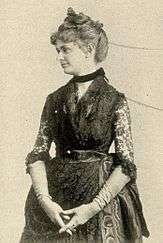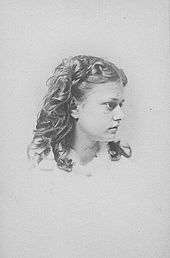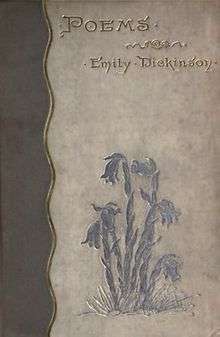Mabel Loomis Todd
| Mabel Loomis Todd | |
|---|---|
 Mabel Loomis Todd, circa 1897 | |
| Born |
Mabel Loomis November 10, 1856 Cambridge, Massachusetts |
| Died |
October 14, 1932 (aged 75) Hog Island, Maine |
| Occupation | Writer and editor |
| Nationality | American |
| Subject | Emily Dickinson |
| Spouse | David Peck Todd |
| Children | Millicent Todd Bingham |
Mabel Loomis Todd or Mabel Loomis (November 10, 1856 – October 14, 1932) was an American editor and writer. She is remembered as the editor of posthumously published editions of Emily Dickinson and also wrote several novels and logs of her travel with her husband, astronomer David Peck Todd.
Todd's relationship to the Dickinson family was complicated. She had a lengthy affair with Emily's married older brother William Austin Dickinson. In preparing Emily's poetry for publication, which was also marred by family controversies, she freely edited and adapted the writing to suit her own style.
Biography

She was born Mabel Loomis on November 10, 1856, the daughter of Mary Alden Wilder and Eben Jenks Loomis.[1] Though her family traced its lineage to such New England luminaries as Priscilla Alden, they led financially difficult lives and Mabel spent much of her childhood in boardinghouses in Cambridge, Massachusetts, Concord, Massachusetts, and Washington, D.C.[1] She graduated from Georgetown Seminary in Washington, then studied music at the New England Conservatory in Boston.
She met astronomer David Peck Todd in 1877, and evidently knew he was a philanderer even before their wedding on March 5, 1879.[1] The couple had one daughter, Millicent Todd (Bingham) (1880 - 1968). Todd had a passionate sexual nature and wrote freely about it. She wrote soon after her marriage: "Sweet communions. Oh joy! Oh! Bliss unutterable" and "A little Heaven just after dinner."
They moved to Amherst, Massachusetts in 1881, where her husband had been offered a position as astronomy professor at his alma mater, Amherst College.[1]
The Amherst Years
It was in this town that she had an affair with Austin Dickinson, the (married) brother of Emily Dickinson[2]; Austin was a prominent local lawyer who served as treasurer of Amherst College. They took private trips to the country together, spent time together in Boston, and wrote love letters to one another. Though they tried to conceal the affair, many people were aware of it.[3]
Todd had been concerned over moving to a small town, as her life might not be as exciting as it had been in cosmopolitan Washington or Boston, but she soon found ample outlets for her energies. She joined the church choir, was active in local theatrical performances, and her diaries are full of accounts of activities – “coaching parties to Mount Toby or Titan’s Pier, sugaring-off parties, bowling and archery contests, horseback riding – one June morning she speaks of riding to Leverett before breakfast – and even tobogganing...”[4]
She accompanied her husband David when he traveled to Japan 1887 to photograph the solar eclipse, and she was the first Western woman to walk up Mount Fuji.{{sfn|Bingham|1935|p=8-9. She accompanied David in his other efforts to photograph eclipses, traveling with him back to Japan in 1896, to Tripoli in 1900 and 1905, to the Dutch East Indies in 1901, to Chile in 1907, and to Russia in 1914.[5]
The Russian trip was their last international voyage. The eclipse occurred on August 21, 1914, but Russia had entered World War I on August 1 by declaring war on Germany, while the Todds were en route from Kiev to Moscow. In the resulting confusion the astronomers had to abandon their project and their equipment and flee the continent by way of Sweden and Denmark.[6]
In 1893 she accompanied David to the World's Columbian Exposition in Chicago.[7]
From 1894 to 1913 she worked on Village Improvement in Amherst, preserving old trees, and she supported Frederick Law Olmsted’s plans for Amherst.[8] The national organization of the Daughters of the American Revolution was founded in 1890, and Mabel was instrumental in starting local chapters – in 1896 she helped found the Mary Mattoon chapter in Amherst[9] and the Betty Allen chapter in Northampton.[10] She helped found the Amherst Woman’s Club in 1893[11] and was instrumental in founding the Amherst Historical Society in 1902 and in securing its permanent home in the Strong House in Amherst.[12]
She was a talented painter, and had studied music – harmony, singing, and piano – at the New England Conservatory in Boston. While she was in Amherst she started a music club; she also gave lessons in painting, singing, and piano. When she turned 40, in 1896, she stopped singing in public.[13].
From 1890 to 1913 she went on regular lecture tours up and down the east coast, as far south as Florida and as far west as California, talking about her travels and other topics of interest. Between 1880 and 1913 she wrote or edited twelve books and hundreds of articles on literature, astronomy, and travel.
By 1917, David’s deteriorating health and erratic mental behavior caused Amherst president Alexander Meiklejohn to force his early retirement from the College, and the couple moved to Coconut Grove, Florida,[14] where David was institutionalized in 1922. Mabel continued to advocate for civic causes, especially preservation of nature and the wilderness; she was active in helping the Audubon Society (incorporated in 1905) preserve Hog Island, Maine, from development.
Mabel Loomis Todd died of a cerebral hemorrhage on October 14, 1932, on Hog Island, Maine. She and David are buried in Wildwood Cemetery in Amherst near the grave of Austin Dickinson.
Editor of Dickinson's poetry

Todd never met Emily Dickinson in person,[15] and though the two women exchanged letters, it has been said that "Mabel effectively destroyed the Dickinson family".[16] Her first reference to Dickinson came in a letter to her parents dated November 6, 1881, a couple of months after moving to Amherst, in which she references her reclusive nature and claims she has not left the house in 15 years. She refers to her as "a lady whom the people call the Myth. She is a sister of Mr. Dickinson, & seems to be the climax of all the family oddity".[17]
After Dickinson's death in 1886, her younger sister Lavinia Norcross Dickinson destroyed all her letters, as she had been instructed. Dickinson had left no instructions for her poems, however, and originally asked her sister-in-law Susan Dickinson to oversee their publication. When Susan's work didn't quickly move the publication project forward—Susan wanted to publish the poems in a holistic volume contextualized with Dickinson's letters, jokes, manuscripts, and drawings, a publication that would be very unconventional for the time but perhaps more authentic to Dickinson's writings[18]—Lavinia enlisted Todd and Thomas Wentworth Higginson.[19] The first volume of Poems by Emily Dickinson was published in 1890, and included many alterations by Todd. Higginson, who had supported Emily's writing in her lifetime and was a friendly correspondent, also collaborated with Todd on Poems: Second Series in 1891. Higginson, however, disliked Todd's alterations of the work and withdrew from further editorial collaboration. Todd edited a two volume set of Dickinson's letters (1894) and Poems: Third Series (1896) on her own. A detailed account of the publication process is given in Ancestors' Brocades, by Millicent Todd Bingham (1945). According to scholar Brenda Wineapple, the third book, without Higginson's pleas to alter as little as possible, "is the most expurgated."[20]
The relationship between Todd and the Dickinson family, however, proved difficult. Emily's younger sister Lavinia, who controlled the copyright of the poems, wanted to give royalty payments to Todd herself instead of having the publisher divide proceeds. The argument was unnecessary as there were no profits.[21] In 1896, Todd and the Dickinson family had a falling-out over a legal battle regarding property owned by Austin Dickinson. Austin had left Todd and her husband a strip of his land and Lavinia had begun the process to make it legal before changing her mind and suing them in 1898 for the claim. She won the lawsuit but Todd refused to continue the project during Lavinia's lifetime.[22] As a result of their disagreements, Emily Dickinson's manuscripts were split between the two families.
Martha Dickinson Bianchi, the poet's niece, inherited the poet's manuscripts from her mother Susan, except for those in Todd's possession. Between 1913 and 1937, she produced four books of Emily's poetry and two biographies, occasionally with assistance from Alfred Leete Hampton.[23] Todd, upset at the rival publications and assuming only she had legal rights to Emily's works, released an updated edition of her compilation in 1931.[24] In 1945, Todd's daughter Millicent published some of the poems from Todd's portion of the manuscripts.[25] By 1955, she had published three more.[26]
Works
Original works
- Todd, Mabel Loomis (1883). Footprints. OCLC 2692762.
- —— (1894). Total Eclipses of the Sun. Columbian Knowledge Series. Boston: Roberts Brothers. OCLC 3838009.
- —— (1898). Corona and Coronet: Being a Narrative of the Amherst Eclipse Expedition to Japan. Boston and New York: Houghton, Mifflin and Company. OCLC 931060.
- —— (1906). Witchcraft in New England. Springfiled, MA: F.A. Bassette Company. OCLC 528846.
- —— (1910). A Cycle of Sunsets. Boston: Small, Maynard and Co. OCLC 3837985.
- —— (1912). Tripoli the Mysterious. Boston: Small, Maynard and Co. OCLC 4725475.
Edited volumes
Todd, Mabel Loomis, ed. (1896) A Cycle of Sonnets. Boston: Roberts Brothers.
Poems of Emily Dickinson
- Dickinson, Emily (1890). Todd, Mabel Loomis; Higginson, T. W., eds. Poems by Emily Dickinson. Boston: Roberts Brothers. OCLC 551319074.
- —— (1891). Todd, Mabel Loomis; Higginson, T. W., eds. Poems, Second Series. Boston: Roberts Brothers. OCLC 858413163.
- —— (1896). Todd, Mabel Loomis, ed. Poems,Third Series. Boston: Roberts Brothers. OCLC 29187960.
Letters of Emily Dickinson
Other poems
Articles (selected)
- —— (May 1895). "Emily Dickinson's Letters". The Bachelor of Arts. 1 (1): 39–66.
Manuscripts
References
Notes
- 1 2 3 4 Leiter 2007, p. 387.
- ↑ Longsworth 2010.
- ↑ Gay 1984, p. 90.
- ↑ Bingham 1935, p. 6.
- ↑ Bingham 1935, p. 46-49.
- ↑ Dobrow 2014.
- ↑ Bingham 1935, p. 13.
- ↑ Bingham 1935, p. 18-19.
- ↑ Bingham 1935, p. 21.
- ↑ Bingham 1935, p. 24.
- ↑ Bingham 1935, p. 13-16.
- ↑ Bingham 1935, p. 40-41.
- ↑ Bingham 1935, p. 40.
- ↑ Bingham 1944, p. 398.
- ↑ Leiter 2007, p. 389.
- ↑ "Emily Dickinson, Sweeping up the Heart". The Economist: 83. 7 August 2010.
- ↑ Sewall 1974, p. 216.
- ↑ Smith 1994.
- ↑ Leiter 2007, p. 284–285.
- ↑ Wineapple 2008, p. 299.
- ↑ Wineapple 2008, p. 298.
- ↑ Leiter 2007, p. 285.
- ↑ Longsworth 1997, p. 38.
- ↑ Longsworth 1997, p. 38–39.
- ↑ Smith 1998.
- ↑ Longsworth 1997, p. 39.
Sources
- Bingham, Millicent (1944). Ancestors' Brocades: The Literary Debut of Emily Dickinson. New York: Harper & Brothers Publishers. OCLC 221563777.
- Bingham, Millicent (1935). Mabel Loomis Todd, Her Contributions to the Town of Amherst. New York: George Grady Press. OCLC 9178337.
- Dobrow, Julie (29 July 2014), "Mabel Loomis Todd in the World", Amherst Historical Society and Museum .
- Gay, Peter (1984). Education of the Senses: The Bourgeois Experience: Victoria to Freud. New York: W. W. Norton and Company. ISBN 0-393-31904-0.
- Leiter, Sharon (2007). Critical Companion to Emily Dickinson: A Literary Reference to Her Life and Work. New York: Facts on File, Inc. ISBN 0-8160-5448-7.
- Longsworth, Polly (1997), "'Whose But Her Shy—Immortal Face': The Poet's Visage in the Popular Imagination", in Danly, Susan, Language as Object: Emily Dickinson and Contemporary Art, Amherst, MA: Amherst College Press, ISBN 1-55849-066-3 .
- Longsworth, Polly (2010). Austin and Mabel: The Amherst Affair & Love Letters of Austin Dickinson and Mabel Loomis Todd. New York: Penguin. ISBN 0374107165.
- Sewall, Richard B. (1974). The Life of Emily Dickinson. Cambridge, MA: Harvard University Press. ISBN 0-674-53080-2.
- Smith, Martha Nell (1994), "Susan and Emily Dickinson: Their Lives in Letters", Dickinson Electronic Archives .
- Smith, Martha Nell (1998), "Dickinson's Manuscripts", in Grabher, Gudrun; Hagenbuchle, Roland; Miller, Cristanne, The Emily Dickinson Handbook, Amherst, Massachusetts: University of Massachusetts Press, pp. 113–137, ISBN 155849488X .
- Wineapple, Brenda (2008). White Heat: The Friendship of Emily Dickinson & Thomas Wentworth Higginson. New York: Alfred A. Knopf. ISBN 978-14000-4401-6.
External links
| Wikimedia Commons has media related to Mabel Loomis Todd. |
